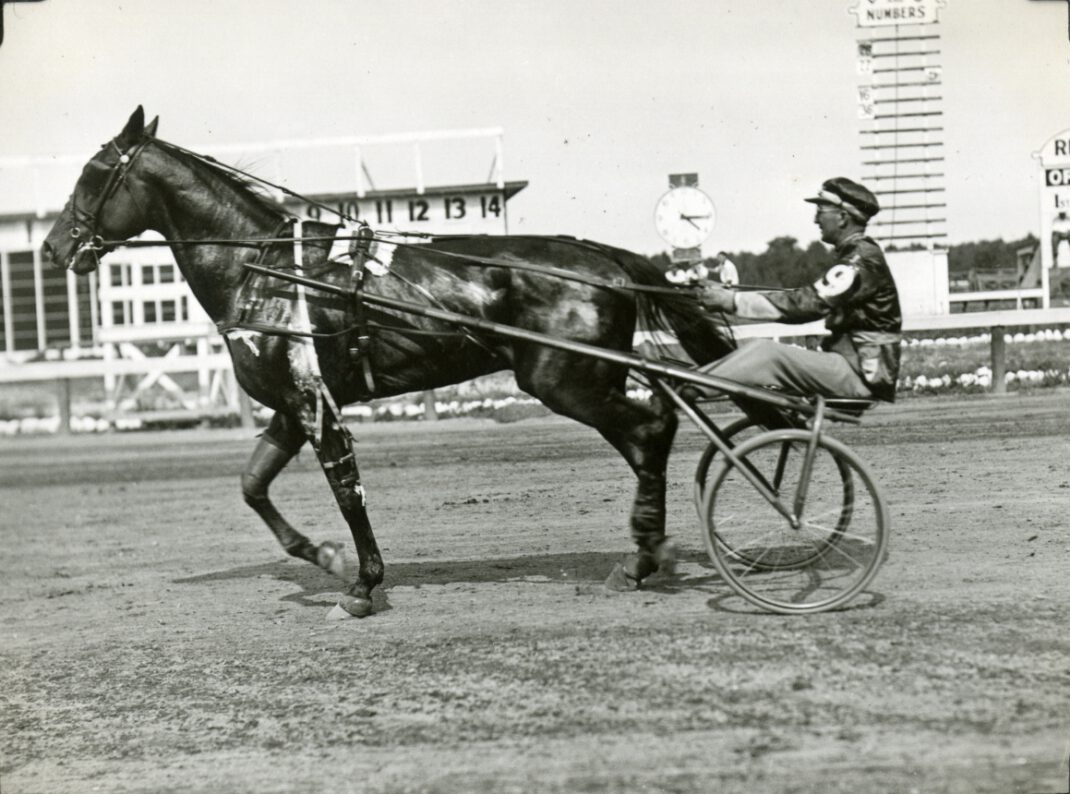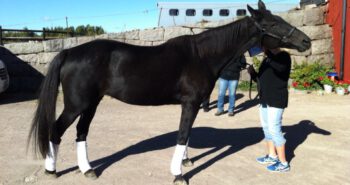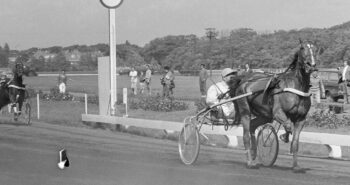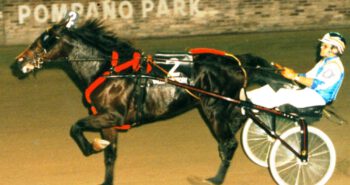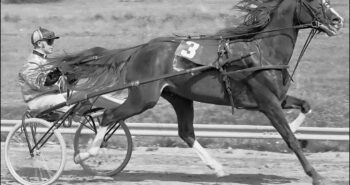He was the talent that didn’t quite live up to his pedigree and the expectations. Sold to Europe, Brother Hanover produced tremendously well at stud in both the Netherlands and Germany and was an active stallion until his 30s.
The 1927 US crop was all about one horse: Hanover’s Bertha. The filly set world records at 2 and 3 and barely lost a race, even when the other drivers colluded against her in the Hambletonian. But Hanover Shoe Farms didn’t just have one good trotter that year – in Brother Hanover they had another one almost as talented. Incidentally, neither was bred by Hanover. When AB Coxe died in April 1926, Lawrence Sheppard bought all of his horses for $150,000 in a deal that overnight transformed the Pennsylvania farm into a powerhouse in the sport. In that deal were broodmares Miss Bertha Dillon and Sister Bertha, both in foal to Peter Volo, and Hanover’s Bertha and Brother Hanover were born the following spring.
In blood Brother Hanover was indeed a brother to Hanover’s Bertha, as both were by Peter Volo and their dams, Sister Bertha and Miss Bertha Dillon, were full sisters. Sister Bertha 3, 2:02 3/4 (1.16.3) was a classy trotter, a world champion at 3 and a winner of the Horse Review and the Matron. With her abilities and pedigree, expectations to her as a broodmare were naturally high – and Brother Hanover showed immediate promise. In May as a two-year-old Tom Berry started both him and Hanover’s Bertha against the clock to beat 2:30 1/4, so as to qualify as a true “standardbred.” Neither “sibling” disappointed: Hanover’s Bertha trotted in 2:12 (1.22,0) while Brother Hanover finished his mile in a very respectable 2:15 (1.23.9) clocking.
Taking it relatively ease with the talented duo, Berry started Brother Hanover only five times at 2 and he never had to face Bertha. In July, while the filly set a world record for two heats at Grand Rapids, Berry opted to let the colt run another time trial. There Brother Hanover lowered his record to 2:09 1/4 (1.20,3), and on his debut in Detroit on August 2 he had no problems sweeping both heats. Keeping the filly away, Berry and Brother repeated at Hartford two weeks later. The Horse Review at Goshen was taken home in three heats after losing the first to Pola McElwyn. Only in the Horseman Futurity at Indianapolis did he taste defeat as Main Mcelwyn and Ben White proved too difficult. He rounded off his debut season with a win at Lexington in October and was 4-1-0 in only 5 starts at 2.
Struggling to follow up
Berry gave Brother Hanover a lengthy break as he returned to the track in the Horse Review Futurity on August 20, 1930. The 3-year-old put in two very good efforts, but could not beat Hanover’s Bertha, who won in 2:03 and 2:01 1/4 (1.16,4 and 1.15,4). In the second heat, Brother was separately timed in 2:02 1/4 (1.16,0). His second place made him a strong contender for the big race, but he was not at his best on the Hambletonian day. A respectable second-place in the third heat ensured he finished in the money, he was 9-8-2 in the three heats for substitute driver Fred Egan.
In mid-September Hanover’s Bertha fell and injured herself during training at Lexington, and it was at first unclear if she was going to start in the Kentucky Futurity eight days later. Kentucky Futurity rules back then did not permit owners to start more than one horse, but suddenly it looked like Brother Hanover would start and, based on newspaper speculations, he might even be the favorite. As it turned out Bertha recovered nicely and Brother Hanover had to start in the Kentucky State instead. Driven by the deputizing Fred Egan, the pair sat quietly until the last eighth when Brother’s speed was utilized to win, the last quarter in 29 3/4 in the second heat.
Back then, wealthy Europeans made big offers for the top US 3-year-olds at the end of the season and Brother Hanover was no different. But Hanover Shoe Farm clearly didn’t need any money and could afford to say no, hence a $20,000 offer from across the Atlantic was politely refused. Maybe Sheppard thought the horse had more in him and would blossom at 4 and 5? Despite not being an obvious second best in the crop behind his “big sister”, several commentators believed Brother Hanover would have topped a lot of summaries had Hanover’s Bertha not been present. The colt kept racing at 4 and 5, though with mixed success. He was pretty much always in the top-3 at 4 and won a few heats, but didn’t pick up any major wins. He won twice at 5, both times in the National Trotting Handicap where he was handicapped 80 feet. Sheppard probably realized this was as good as it was going to get and with no stallion future in sight at Hanover, where his bloodlines were in abundance anyway, Brother Hanover was auctioned off at the Old Glory sale in New York in November 1932. Lewis A Halleck of Speonk, NY purchased him for “only” $1,500, although that figure reflected the economic situation of the time.
Going Dutch
Halleck didn’t even get to race his horse, however, as the following April Brother Hanover was off to Europe. The Dutchman Maurits van Renswoud had stepped in to purchase the talented trotter for stud duty at his farm at Wassenaar in the Netherlands. Van Renswoud also took advantage of the US depression by importing several broodmares. One mare in particular would play an important role in both Dutch and German pedigrees – this was Evalee Hanover, a full sister to Florican’s sire Spud Hanover. Though the mating of Brother to Evalee produced several very good trotters, two deserve special mention:
1941 saw the birth of Illustre Hanover, one of the best Dutch horses in the mid-40, who started his career with 17 straight wins for trainer Willem Geersen (later of Hairos II fame). WWII forced him to take a break as there were no races in the Netherlands between mid-September 1944 and mid-June 1945, and in the late summer of 1945 he suffered his loss, to French-born Quick Williams and Jan Kruithof. Though he later wasn’t as unbeatable as his career start indicated, Illustre Hanover was a very good trotter who later became an important sire.
Late 1941 both Brother Hanover and Evalee Hanover were sold to Germany. Evalee was already in foal to Brother Hanover, and the resulting mating produced another Hall of Fame-trotter, this time German. Bibijunge was a very good racehorse, winning numerous bigger races and defeating Permit in 1950, but truly excelled as a stallion at Helenenhof a little north of Hamburg. In the siring championship he was top three every year from 1958 to 1968. Bibijunge also sired Heres, the little – he measured only 153 cms (15 hands) at the withers – horse who was champion stallion for many years in the Netherlands.
Brother Hanover and Hanover’s Bertha, despite being by Peter Volo, were both in type described by contemporaries as much more like their damsire Dillon Axworthy, a much more refined type. Brother Hanover generally reproduced himself and Bibijunge and Illustre Hanover were both representatives of their sire, the beautiful lighter type. Brother Hanover was a good stallion in both countries. He was champion stallion in West Germany in 1949 and was top-3 in that list until 1956. Brother Hanover’s best get on the track was not Bibijunge, though, but the excellent mare Coronia, trained and driven by Johannes Frömming. Coronia was inducted into the German Hall of Fame, as was her son Corsaro.
Brother Hanover had a long life and passed away in 1959, aged 32, when he died in a fire. He was still an active stallion by then and has a few foals born 1960 at 33!
brother hanover
Bay colt born in Hanover, PA in 1927. Died in Aukrug, Germany in 1959.
Peter Volo – Sister Bertha (Dillon Axworthy)
Fastest win: T3,2:04.1 (1.17,2) – Fastest time: 2:02 1/4 (1.16,0)
Breeder: AB Coxe
Owners: Lawrence Sheppard – Lewis A Halleck – Maurits van Renswoud – Karl Theo Schmidt
Trainer: Tom Berry
Drivers: Tom Berry and Fred Egan
Groom: –

